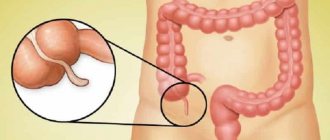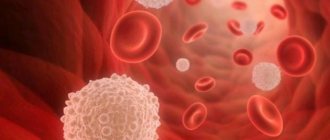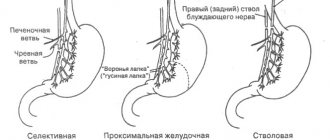Is it possible to remove appendicitis by laparoscopy? The appendix is removed either traditionally or by laparoscopy. The procedure is performed through a small hole in the abdomen using a thin tube made of optical fiber. Laparoscopic appendectomy makes it possible to accurately identify appendicitis and quickly remove the appendix, including if it is in an unusual location. In case of inflammation of the appendix, observation is carried out and diagnostic laparoscopy is performed, which is called appendicitis laparoscopy.
Application of the laparoscopic method in the diagnosis and removal of appendicitis
Laparoscopic appendectomy differs from classical surgery in that for all manipulations during surgical and diagnostic intervention it requires a small hole in the abdominal wall, approximately 1.5 cm. Classic surgery requires a larger incision that dissects the abdominal tissue layer by layer.
Laparoscopy is used both as a diagnostic method and as a means of removing the appendix. Diagnostic laparoscopy allows the doctor to know the exact location of the inflammation.
This significantly reduces the time of the diagnostic search and the operation itself to remove appendicitis if symptoms of chronic appendicitis were noticed. But when is laparoscopy used according to the clinic?
Possible complications after laparoscopy to remove appendicitis
| By-effect | Frequency of occurrence |
| Perforation of appendicitis due to clamp weakness | Rarely |
| Perforation of the cecum | Rarely |
| Poor closure of the duct of the artery leading to appendicitis, which provokes bleeding | Sometimes |
| Poor sanitation of incisions, sutures and inflamed areas | Sometimes |
| Formation of small hematomas on the abdominal wall | Often |
| Necrotic processes on the remaining part of the appendicitis | Sometimes |
| Hernia formation on incisions | Rarely |
| Development of peritonitis after surgery | Rarely |
| Massive bleeding due to arterial damage | Rarely |
Laparoscopic appendectomy
Attention! In many ways, the occurrence of side effects after surgery depends on the qualifications of the surgeon and the presence of contraindications to the procedure that were ignored.
Indications for laparoscopy for appendicitis
Laparoscopic appendectomy is indicated in the following cases:
- mucocele;
- appendicitis;
- carcinoid tumors;
- benign tumors;
- parasitic lesions;
- cysts.
If possible, appendicitis is removed laparoscopically in the following groups of patients:
- Patients during whose observation it is difficult to exclude the presence of acute inflammation in the appendix.
- Women for whom it is important to achieve the best cosmetic effect.
- Young women planning pregnancy in the future, in whom it is difficult to determine the difference between a gynecological disease and acute appendicitis.
- Children. Laparoscopy is most preferable, since it is accompanied by a low likelihood of developing adhesions.
- Patients who have concomitant pathologies associated with a high risk of developing purulent processes.
Contraindications to the use of laparoscopy for appendicitis
Laparoscopic appendectomy has absolute contraindications, these include the following conditions:
- severe coagulopathy;
- adhesions in the intestines;
- severe pathological processes occurring in the heart, liver, kidneys;
- history of abdominal surgery;
- abscess periappendicular process;
- peritonitis or the appearance of signs of its development;
- inability to use general anesthesia;
- detection of dense infiltrate in the area of the appendix
- processes accompanied by the formation of pus in the abdominal cavity.
Relative contraindications:
- old age;
- severe obesity;
- atypical location of the appendix;
- third trimester of pregnancy;
- disorders in the blood coagulation system;
- there is no idea of the real picture in the inflamed area (if it is not possible to make a diagnosis for a long time, laparoscopy is performed).
It has not been proven that pneumoperitoneum has a negative effect on the fetus, but minimally invasiveness during pregnancy is most preferable, since it allows you not to harm the baby and recover faster.
If blood clotting is impaired, serious bleeding may occur, but if appendicitis occurs, treatment is required in any case and it is desirable that it be less traumatic. The patient is prescribed replacement therapy, so blood loss is usually insignificant.
If you are overweight, the doctor may decide to perform laparoscopy, but only in cases where there are no aggravating circumstances. For obese patients, this technique is often chosen because abdominal surgery carries higher risks.
Contraindications
The main indications for laparoscopy and removal of appendicitis using laparoscopy are symptoms of acute and chronic forms of appendicitis.
These conditions are evidenced by a clear clinical picture and changes detected by laboratory and instrumental examination methods. The list of contraindications is quite wide and includes both absolute and relative contraindications. The absolute ones include:
- Late pregnancy.
Traditionally, pregnancy has been considered an absolute contraindication for laparoscopy.
- Presence of contraindications to the use of anesthesia.
- Blood clotting disorders (hemophilia and other conditions with reduced blood clotting).
- No signs of inflammation of the appendix.
- Diffuse purulent inflammation in the retroperitoneal region.
- Appendicular infiltrate, representing a tightly fused appendix with intestinal loops.
Relative contraindications include the following situations:
- Increased body weight, making it difficult to access the abdominal cavity through laparoscopy.
- Previous diseases of the abdominal organs due to the risk of developing adhesions.
- Peritonitis, since the optimal treatment for it is wide laparotomy.
As a rule, recovery from appendicitis lasts at least 0.5 months.
The recovery period depends on how successfully the operation was performed, what method was used, how the body responded to the intervention, and the severity of the situation. After removal of purulent or gangrenous appendicitis, especially one that has turned into peritonitis, the rehabilitation period is longer, since there is a need to combat the infection that has developed, which includes long-term use of antibacterial drugs.
Today, appendectomy is performed by laparoscopy or abdominal surgery. Laparoscopic intervention is possible if the organ is inflamed, but tissue rupture has not yet occurred. This easy surgical treatment option provides for recovery after appendicitis removal within 2 weeks, less often 4.
Laparoscopic appendectomy is a minimally invasive surgical method that allows you to remove the inflamed appendix with minimal trauma. During the operation, the surgeon uses a laparoscope, or endoscope, which penetrates the abdominal cavity through a centimeter hole in the patient's abdomen.
A laparoscope is an optical tube made of metal with a video camera that contains 2 optical channels. One of them conducts light, which makes the area being operated easier to see. In the second, an image of the abdominal cavity is brought to the camera. The outer working diameter of the device is 10 mm.
In addition to the laparoscope, during surgery to remove appendicitis, the following are used:
- illuminator;
- clamps;
- forceps;
- electrocoagulator;
- insufflator
The image obtained from the laparoscope is fed to a video monitor and becomes available to the surgeons performing the operation
Laparoscopic appendectomy differs from classical surgery in that for all manipulations during surgical and diagnostic intervention it requires a small hole in the abdominal wall, approximately 1.5 cm. Classic surgery requires a larger incision that dissects the abdominal tissue layer by layer.
Laparoscopy is used both as a diagnostic method and as a means of removing the appendix. Diagnostic laparoscopy allows the doctor to know the exact location of the inflammation.
This significantly reduces the time of the diagnostic search and the operation itself to remove appendicitis if symptoms of chronic appendicitis were noticed. But when is laparoscopy used according to the clinic?
Laparoscopic appendectomy has absolute contraindications, these include the following conditions:
- severe coagulopathy;
- adhesions in the intestines;
- severe pathological processes occurring in the heart, liver, kidneys;
- history of abdominal surgery;
- abscess periappendicular process;
- peritonitis or the appearance of signs of its development;
- inability to use general anesthesia;
- detection of dense infiltrate in the area of the appendix
- processes accompanied by the formation of pus in the abdominal cavity.
Relative contraindications:
- old age;
- severe obesity;
- atypical location of the appendix;
- third trimester of pregnancy;
- disorders in the blood coagulation system;
- there is no idea of the real picture in the inflamed area (if it is not possible to make a diagnosis for a long time, laparoscopy is performed).
It has not been proven that pneumoperitoneum has a negative effect on the fetus, but minimally invasiveness during pregnancy is most preferable, since it allows you not to harm the baby and recover faster.
If blood clotting is impaired, serious bleeding may occur, but if appendicitis occurs, treatment is required in any case and it is desirable that it be less traumatic. The patient is prescribed replacement therapy, so blood loss is usually insignificant.
If you are overweight, the doctor may decide to perform laparoscopy, but only in cases where there are no aggravating circumstances. For obese patients, this technique is often chosen because abdominal surgery carries higher risks.
Removing appendicitis by laparoscopy has the following advantages:
- excellent cosmetic effect;
- minimal trauma;
- fast rehabilitation;
- lower incidence of complications;
- economic benefit associated with short hospitalization
- the ability to conduct a full examination of internal organs and perform additional operations without widening the incision.
Flaws:
- requires expensive equipment;
- staff need to be trained;
- inability to implement the technique for some concomitant pathologies.
Such surgical interventions, however, are not possible for everyone - in some cases there are contraindications.
Among the general contraindications are absolute:
- late pregnancy;
- intolerance to anesthesia;
- blood clotting disorder.
Relative contraindications include:
- overweight;
- previous operations.
According to local absolute contraindications, the following are undesirable:
- absence of inflammatory signs in the appendix;
- severe appendicular infiltrate;
- retroperitoneal phlegmon.
Local relative contraindications should not include:
- interintestinal adhesions;
- inflammation of the peritoneum.
Despite the fact that this technique is one of the safest and most gentle, it cannot be used for the following contraindications:
- problems with blood clotting;
- last trimester of pregnancy;
- inability to use general anesthesia;
- the patient has a history of abdominal surgery;
- the patient’s body weight is too large with a significant fat layer at the site of the incisions;
- there is no data on the actual inflammatory process, but if it is impossible for a long period of time to determine an accurate diagnosis, laparoscopy is still performed, but more as a diagnostic method;
- there are serious purulent processes outside the abdominal area;
- registration of dense infiltration in the affected area;
- the appearance of signs of possibly developing peritonitis or its actual development;
- the presence of adhesions on the intestines.
Abdominal surgery is a serious test for the patient’s health. In this regard, the laparoscopy method is several times safer and more productive. The patient does not require a long stay in a medical hospital, and there is no increased pain during the recovery period. The intestines are also restored several times faster, which relieves the patient of problems such as constipation or diarrhea. This in turn reduces the risk of dehydration or intoxication during the recovery period.
Typically, such an intervention is planned in advance, since in emergency cases, almost 100% of patients are operated on using the abdominal method. To carry out the intervention, the specialist will always require blood tests and ultrasound results. In the acute type of the disease, an x-ray examination is required, during which a specialist may detect additional difficulties in the form of accumulated hard feces and other disorders. Anamnesis must be checked for the contraindications described above. The operation is always performed strictly under general anesthesia.
If the operation is planned and is not acute, the patient is prepared for it as much as possible. An enema must be prescribed, which will eliminate accumulated feces and relieve increased gas formation, which can interfere with the normal work of the surgeon. Also, two hours before the start of surgery, the patient is given therapeutic doses of antibiotics and sedatives. If the patient's condition quickly deteriorates, he is given doses of antibiotics and immediately sent to the operating table.
The operation itself consists of several mandatory steps:
- the surgeon carefully examines the patient’s abdominal cavity for external and other injuries;
- then the sore spot is treated with an antiseptic drug and an incision is made;
- for the convenience of the specialist and the safety of the patient, two upper and two lower incisions are made on both sides of the abdomen;
- the specialist inserts a special tube with a camera into the incision, with the help of which he once again carefully examines the abdominal cavity, but this time inside the patient;
- Using special forceps, the surgeon exposes and slightly pulls the appendix towards the incisions;
- the next stage of the operation is excision of the mesenteric part of the intestine;
- as soon as the mesentery is excised, special forceps grasp the inflamed process and remove it;
- simultaneously with its removal, the specialist sanitizes the cut so that the inflammatory process does not advance through the digestive system;
- Only after antiseptic treatment is the appendix removed through the incisions;
- as soon as it is removed, complete sanitation of the peritoneum is also carried out, and if peritonitis develops, drainage is installed;
- after removal, the doctor examines the wound again so that there is no pus or working tools left in it;
- The last stage of treatment is suturing and external treatment of the incisions with an antiseptic.
| By-effect | Frequency of occurrence |
| Perforation of appendicitis due to clamp weakness | Rarely |
| Perforation of the cecum | Rarely |
| Poor closure of the duct of the artery leading to appendicitis, which provokes bleeding | Sometimes |
| Poor sanitation of incisions, sutures and inflamed areas | Sometimes |
| Formation of small hematomas on the abdominal wall | Often |
| Necrotic processes on the remaining part of the appendicitis | Sometimes |
| Hernia formation on incisions | Rarely |
| Development of peritonitis after surgery | Rarely |
| Massive bleeding due to arterial damage | Rarely |
Advantages and disadvantages of the method
Removing appendicitis by laparoscopy has the following advantages:
- excellent cosmetic effect;
- minimal trauma;
- fast rehabilitation;
- lower incidence of complications;
- economic benefit associated with short hospitalization
- the ability to conduct a full examination of internal organs and perform additional operations without widening the incision.
Flaws:
- requires expensive equipment;
- staff need to be trained;
- inability to implement the technique for some concomitant pathologies.
Preparing for surgery
Typically, laparoscopic appendectomy requires preparation. When it is necessary to act urgently, the abdominal method is almost always chosen, since there is no time for a thorough examination, which shows how the intestine is displaced from inflammation. The list of required studies is as follows:
- coagulogram;
- ultrasound examination of the abdominal organs;
- urine and blood tests;
- tests for the presence of hepatitis and syphilis;
- reaction to HIV;
- X-ray (performed in acute forms of the disease);
- ECG (performed in some cases).
The preoperative examination is performed in the emergency room; this is a short process. Next, the patient is sent to the surgical department, where they talk with an anesthesiologist and surgeon. Of course, in difficult cases, the operation is performed as soon as possible. If there are doubts about the diagnosis and the advisability of surgery, the doctor may decide to postpone the operation. The patient is under observation and may undergo diagnostic laparoscopy.
The patient is carefully prepared for a planned operation. An enema is given to remove accumulated stool and eliminate gases that may interfere with the surgeon's work. 2 hours before removal of the appendix, antibiotics and sedatives are administered to the patient's body. If the patient's condition rapidly deteriorates, the patient is sent to the operating room immediately after medication is administered.
The preparatory stage lasts a maximum of 2 hours. Infusion therapy and treatment of the surgical field are performed.
Types of surgical operations
Laparoscopy for appendicitis is used to diagnose its acute and chronic forms. As a rule, confirmation of such a diagnosis is a direct indication for surgery. The main goal of all types of surgical intervention for acute appendicitis is to remove the inflamed appendix. There are two main approaches to treatment:
- using wide access and an incision in the anterior abdominal wall;
- using endoscopic laparoscopy, which allows you to examine and remove the appendix through small punctures in the abdominal wall.
Types of incisions depending on the method of removing the inflamed appendix
Laparotomy, used for the classic removal of the appendix, is a large surgical intervention with an 8-15 cm long incision in the anterior abdominal wall. In this case, the surgeon has wide access to the affected organ and can easily perform an appendectomy, i.e.
During laparoscopy, laparoscopic instruments and the laparoscope itself are introduced through small punctures into the abdominal cavity, allowing visual monitoring of the operation. Such an operation reduces the length of hospitalization of the patient and facilitates the postoperative period, reducing cosmetic defects, since it does not leave large scars on the skin.
The main advantages of laparoscopic appendicitis removal are as follows:
- Reducing the intensity and duration of pain.
- Faster restoration of the functions of internal organs (motility of the small and large intestines, etc.).
- Reducing the length of stay in a medical institution.
- Short period of patient incapacity.
- No scars after surgery.
A – scars after laparoscopy;
B – scars after laparotomy It is important to note that, ultimately, only the attending physician makes a choice between laparotomy and laparoscopy, who makes a decision based on the clinical picture of the disease and the characteristics of the patient’s body.
The course of the operation or how appendicitis is removed using laparoscopy
For laparoscopic removal of appendicitis, general anesthesia is used. During the operation, the patient is in a horizontal position on a table that is slightly tilted to the left. All actions are performed through three punctures after antiseptic treatment, made in the right iliac region, where the appendix is located. The first incision is located above the umbilical ring, at this point a laparoscope with video equipment and lighting is inserted, the second - in the area between the womb and the navel, the third incision is made taking into account the location of the appendix, when inflamed, the cecum moves to the side.
The course of the operation is as follows:
- Examination of the abdominal cavity.
- Treatment of the abdomen with an antiseptic composition.
- A needle is inserted into the inflamed area of the abdomen.
- Injection of air to provide better visualization.
- Making incisions in the abdominal wall.
- Insertion of a special tube equipped with a camera.
- Internal examination of the abdominal cavity.
- The use of special forceps to expose and bring the appendage slightly closer to the incisions.
- Excision of the mesenteric part of the intestine.
- Grasp the process with forceps, remove and sanitize the cut.
- Removing the appendix.
- Examination of other organs to exclude complications.
- Complete sanitation of the peritoneum (if peritonitis develops, drainage is installed).
- Inspection of the wound.
- Stitching.
- Treatment of cuts with an antiseptic composition on the inside.
The operation to remove appendicitis takes approximately 30 minutes. The patient spends mostly 2-3 days (sometimes 3-7) in a medical facility; this time is enough to normalize the condition. Discharge takes place on the third day, the pain disappears after about 7 days. The drainage tube in the puncture area is removed one day after the appendix is removed.
Eating is possible the next day, but the food must be dietary. To prevent unnecessary stress on the intestines, it is recommended to consume food in the form of purees. Some foods are excluded from the diet, these are grapes, legumes and cabbage, as well as other foods that increase gas formation. Normal lifestyle can be resumed 3-4 weeks after surgery.
Recovery period: how long to get up and how to behave in the first months
After removal of the appendix using the laparoscopic method, there is no long recovery. Recovery from appendicitis is quite quick and does not require special rehabilitation after laparoscopy. Complete physical activity is excluded only for a few hours. The next day after surgery, you can get up and even walk, but not much. Training, physical activity and carrying heavy loads are permissible only after 2 months, when the intestines have healed in the area where the cut was made.
While the patient is in the hospital, infusion treatment is performed and antibiotics are administered. On the first day after removal of the appendix of the cecum, pain may be present in areas where the integrity of the tissues is damaged and sutures are applied, which is why anesthetics are used.
Sutures are removed in a clinic or hospital 1-1.5 weeks after surgery. Since the stitches are small, the procedure is almost painless. The surgeon can use self-absorbing threads, with which the patient does not have to undergo suture removal.
The day after laparoscopy, it is recommended to take only drinks and liquid food. In the future, gentle nutrition is indicated; this requires rapid recovery. A week after the operation, it is possible to switch to a normal diet. But this does not apply to alcoholic drinks. Alcohol can be consumed 45-60 days after an appendectomy. This period is minimal; it is advisable to abstain from drinking alcoholic beverages for as long as possible. If you want to resume drinking alcohol, you should start with small amounts of light drinks. For example, you can take 100 ml of high-quality red wine. This amount is enough for the first dose.
Moderate physical activity promotes a speedy recovery. In addition, light loads can reduce the risk of complications in the postoperative period.
To prevent scars from spreading, do not lift heavy objects or perform exercises that increase intra-abdominal pressure. Such exercises can be introduced only after completing the rehabilitation course. Work that requires significant physical effort can also be started only after complete recovery.
Possible complications
Laparoscopy for appendicitis in a patient can develop the following complications:
- hernia of the anterior abdominal wall;
- scars and adhesions in the intervention area;
- violation of the integrity of blood vessels with blood loss in the abdominal cavity;
- the addition of a secondary infectious process, including in areas where the surgeon made incisions;
- intra-abdominal abscess, peritonitis (such complications occur much less frequently than during a classic appendectomy);
- acute typhlitis (observed in cases where, as a result of careless handling of the coagulator, a burn of the cecum occurs, blood and pus appear; a complication manifests itself with increased body temperature and pain in the affected area);
- hypotension associated with the injection of gas into the abdominal cavity, the introduction of certain medicinal compounds, disturbances in the functioning of the heart and other internal organs.
In patients who have been operated on for other surgical pathologies, during laparoscopy the risk of damage to nearby organs due to adhesions increases, so the surgeon must act as carefully as possible.
Laparoscopy for appendicitis is an effective and safe method for treating an inflamed appendix, but only if the operation is performed by a highly qualified doctor who has enough experience to perform such operations.
Possible complications and how to avoid them
Complications that may arise after a poorly performed operation often include:
- long-term preservation of temperature (38°, sometimes higher);
- suture dehiscence, compaction and hyperemia of the wound edges;
- the appearance of purulent discharge;
- stomach ache;
- blood poisoning;
- vein thrombosis;
- adhesions;
- respiratory and cardiovascular dysfunctions;
- abscess;
- deformation, protrusion of the contents of the abdominal cavity in the area of the wound - hernia.
Such complications often develop with purulent appendicitis, a spill of the contents of the inflamed appendix into the abdominal cavity. Poor healing of surgical sutures can be caused by weak immunity, and not just by doctors’ mistakes. In this case, repeat surgery may be required.
The period of standard rehabilitation after surgery for appendicitis may increase if recovery measures are carried out incorrectly or the doctor’s advice is ignored.
The patient returns home 1-2 weeks after surgery, leaves the control of doctors and is responsible for his own health. In addition to external sutures, there are also internal ones, which can come apart in a fairly long time, after discharge.
Discrepancies can be caused by:
- gases in the intestines caused by poor diet;
- retention of feces due to irregular bowel movements;
- excess food;
- increased load on the peritoneum.











